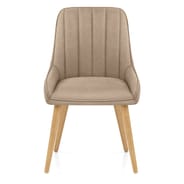Are Ornate Chair Legs Making A Comeback?
By Sophie Hardy, 24th November, 2016
Whilst antique furniture may be an acquired taste for many of us, their fundamental designs and shapes are often the inspiration for modern pieces we see today. As with clothing, different styles frequently go in and out of fashion, with vintage designs regularly making a comeback, the same can be said for furniture. One example is in chair legs, a simple plain frame is typical of today, but designs influenced by the past are beginning to make an appearance.
Traditionally, wooden chairs were hand crafted, focussing on intricate carving on the frame, legs, arms, and back. Today, the seat is seen as the most important feature, with studs, pattern, stitching, and button detailing all taking centre stage, so there is usually a modest leg design as a result. Simple minimalist frames are the norm, with a focus on wood finishes and colours rather than shape and detail. A common belief is that there’s something missing in these designs as Charles H Hayward, an expert on the history of furniture design, suggests:
To counteract this opinion, we strive to bring some of that character and charm back into our designs. Below, we have picked out some of the most renowned antique chair leg designs, discussing their history and how their influence is making its way into our modern-day chairs.
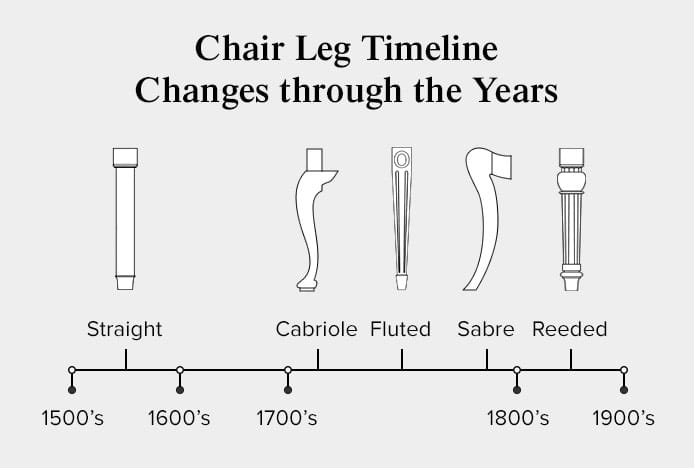
Straight Square Leg
The original and most basic chair designs of the 16th and 17th century had straight square legs with a plain design, but carved, grooved, and moulded designs became common as chairs increased in popularity in domestic homes. Prior to the 18th century they were found on both the front and rear of the chair, with an upright backrest following the straightness of the frame. The front legs were usually decorated with ornate detail, whilst the rear had little embellishment.
-
 Simple Straight Square Leg
Simple Straight Square Leg -
 Carved Straight Square Leg
Carved Straight Square Leg -
 Ornate Straight Square Leg
Ornate Straight Square Leg
This style went out of fashion when more intricate designs and shapes were introduced, but it became popular again by Thomas Chippendale in the 1700’s. In his designs, Chippendale gave it the name Marlborough leg and often added block feet to the design, it was seen as the alternative to the distinguished cabriole style.
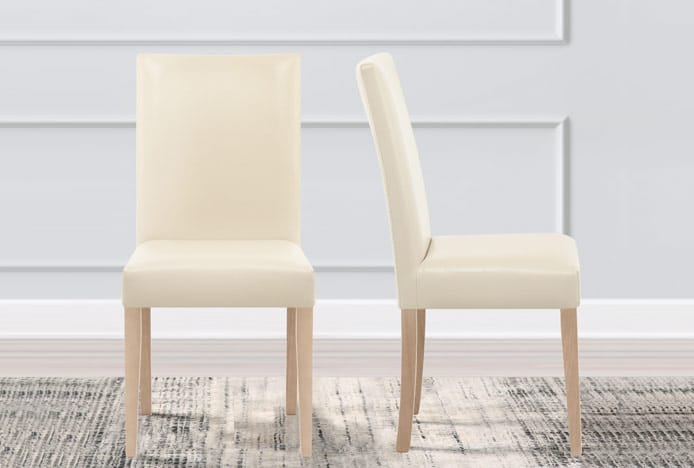
Chicago Oak Dining Chair Cream
Today, simple and plain straight designs are the most common on modern chairs, forming a solid frame without distracting from the seat. Find it on the front legs of our classics, like the Chicago Oak Dining Chair Cream (pictured above).
Cabriole Leg
The cabriole leg is a renowned characteristic of Queen Anne Style furniture, which began in 1702 when Queen Anne took to the throne, and is thought to continue into the second half of the century. Encouraging its development, the cabriole also became a staple feature within Chippendale’s chair designs throughout the late 18th century.
Intended to resemble the shape of an animal leg when leaping or jumping, the classic shape has an outcurve knee and incurved ankle. Hence the name cabriole – derived from the French word ‘cabrioler’, meaning light leap!
-
 Smooth Queen Anne Style Cabriole Leg
Smooth Queen Anne Style Cabriole Leg -
 Cabriole Leg With Claw & Ball Foot
Cabriole Leg With Claw & Ball Foot -
 Slender Cabriole Leg With Pad Foot
Slender Cabriole Leg With Pad Foot
There are many variations on the cabriole depending on the origin and year of the design. Smooth weighty legs with pad feet were common on popular wing back chairs of the early Queen Anne Style. Whilst elaborate carved designs with ball and claw feet could be found on decorative side chairs later on. Chippendale produced more slender versions, often with subtle carving and slipper feet, which were generally more delicate than Queen Anne furniture.
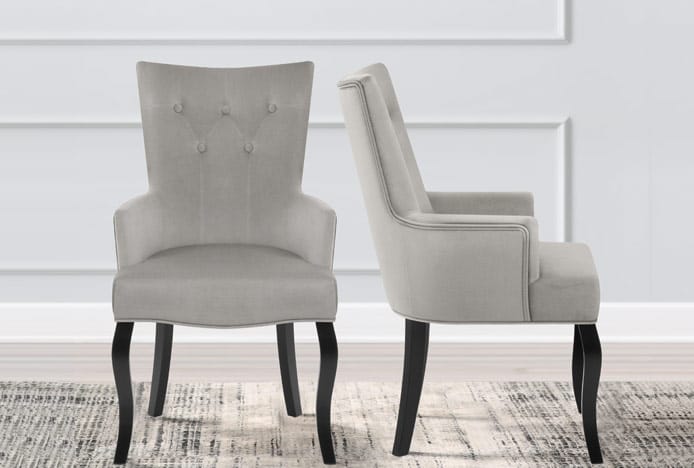
Present-day cabriole designs tend to be simplified, plain, and without carved detail, in order to follow popular minimalist style. So, in an effort to bring classic antique style into the 21st century we have introduced the sophisticated Fleur Chair (pictured above), which incorporates sleek black satin finished cabriole legs – our own contemporary version.
Fluted & Reeded Legs
Generally found on variations of round tapered or square tapered legs, fluting and reeding are styles of carving added to chairs for decoration.
Fluted Legs - Popular in the late 1700’s and early 1800’s, fluted legs have vertical concave grooves carved into them. Chair designer George Heppelwhite embraced the square tapered style in many of his chairs, which were often plain but many were carved with a fluted design.
-
 Square Tapered Fluted Leg
Square Tapered Fluted Leg -
 Round Tapered Reeded Leg
Round Tapered Reeded Leg -
 Fluted Leg With Spade Foot
Fluted Leg With Spade Foot
Reeded Legs - Similar to fluted, reeded legs have carved detail but instead of concave grooves, they have rounded convex ridges. Also used by Heppelwhite in the late 18th century, Thomas Sheraton adopted the design and encouraged its popularity throughout the 1800’s, making it the preferred choice over fluted.
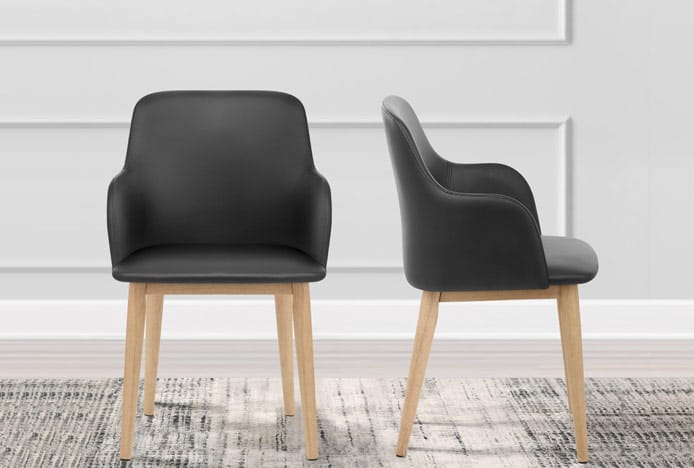
In today’s chairs carved designs are uncommon, but the basic round tapered and square tapered shape is becoming more fashionable, which is a simple smooth version. We are using it more in our modern wooden pieces, for example, the Albany has a sleek round tapered design.
(September 2018 - Please note, the Albany has now been discontinued, but the Tate is another great example.)
Sabre Leg
Made popular in England by furniture designer, Thomas Sheraton, who designed much of the finest furniture in the late 18th century, the sabre leg went on to flourish in the 19th century within Regency Period furniture.
-
 Sabre Leg Wtih Tapered Design
Sabre Leg Wtih Tapered Design -
 Classic Plain Sabre Leg
Classic Plain Sabre Leg -
 Smooth Tapered Sabre Leg
Smooth Tapered Sabre Leg
A gracefully curved design, it is fashioned to mimic the shape of a sabre sword, which is where the name originates. Often tapering as it meets the floor, the leg flares out at the bottom and can be used on both the front and rear of the chair. A rear sabre leg follows the curve of the backrest, increasing the stability of the chair. Up until the late 1600’s chair makers would use a sloped backrest with a straight frame, before realising a raked design would improve balance.

Depending on the date and origin, it may have some carved detail, but generally the sabre is a plain and smooth design, which can be found on the rear of many of our wooden dining chairs. Some of our chrome dining chairs, also have slightly flared rear legs, putting a real contemporary twist on the design and proving that 18th century chairs are still an influence today.
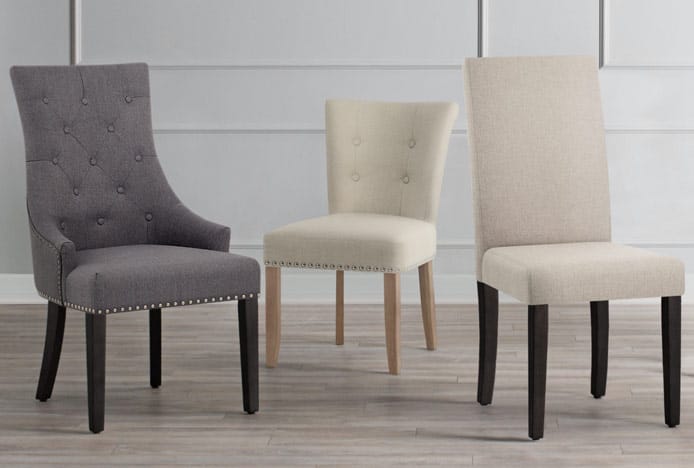
Modern adaptations of these designs are a great way to bring a hint of traditional style to your interior. Plus, with a wider range of resources and technology available today, there is huge potential to bring back carved designs or even plain designs in new materials. For example, a chrome cabriole leg could be seen in the not-so-distant future!
Recommended Articles
Introducing Our New Vintage Industrial Stools
Love the industrial look? You'll love our brand new collection of vintage style stools..
The Use Of Studs In Furniture
Find out how we use studs in our designs, and where the popular trend came from..
Embellishing Stool & Chair Legs With Metal Tips
Metal tips can accent, enhance & modernise your kitchen. Find out how…..
Matching Bar Stool & Chair Designs
From classic to contemporary, check out our range of matching stools and chairs..
Recent Popular Posts
6 Ways to Use Texture in Your Kitchen
Six easy ways that you can use texture to liven up your kitchen design..
How to Brighten up a Dark Kitchen
Whether your kitchen's a small space, or just poorly lit, brighten it up in 5 steps..
3 Easy Steps to Scandinavian Style in Your Home
Featuring natural materials, clean lines and light spaces, Scandi style is clean and cosy..
How to Create a Cosy Corner in Your Home
Staying in is the new going out! Pop the kettle on and relax in a cosy corner..













